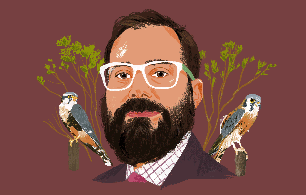
A new ranching generation is taking cues from historical bison herds to help prairies, wildlife, and their businesses survive the next century.
ÃÛèÖAPP’s Working Lands Strategy aims to bring bird-friendly practices to 4.7 million hectares of productive lands in Latin America and the Caribbean, increasing habitat and connectivity across landscapes. This will boost the overwinter survival rate of migratory birds while increasing the abundance of local wildlife, including endemic and threatened birds.
In landscapes that were once natural, enhanced agricultural lands can serve as migratory corridors for wildlife. They connect wetlands, forest blocks, and protected areas and provide environmental benefits to people, including food and water security, flood prevention, and ÃÛèÖAPP mitigation. ÃÛèÖAPP is scaling up nature-based solutions such as habitat restoration, silvopasture systems, and crop-rotation models. Already prototyped in Colombia, these solutions have boosted yields and income for farmers and communities while demonstrating significant environmental benefits.
Cattle ranching is the region’s the greatest agricultural threat to biodiversity, but this sector also provides the greatest opportunity for rapid progress. Silvopasture systems incorporate trees and shrubs into pastureland, providing habitat for birds and improving connectivity in landscapes fragmented by ranching. By incorporating bird-friendly flora into ranch lands and reducing chemical use, we can protect wildlife, soil, and water while improving farmers’ productivity and profitability.
ÃÛèÖAPP is also working with farmers to incorporate nature-based adaptations into cropland. For example, innovative rotation systems for sugarcane and rice crops create intermittent wetlands that provide bird habitat, mitigate flooding, boost biodiversity, and increase farm productivity.
Throughout Latin America and the Caribbean, ÃÛèÖAPP intends to work with landowners, community leaders, protected-area managers, environmental authorities, and local NGOs to expand knowledge and use of these bird-friendly practices. Demonstration projects in prioritized countries are already showing that development that integrates nature-based solutions can achieve conservation and sustainable-development impacts at a significant scale.
ÃÛèÖAPP is kicking off its Working Lands strategy in Colombia via deep interventions in the Cauca Valley region. Via collaborations with local partners, we intend to:
Prioritize and refine restoration activities and bird-friendly practices to achieve the greatest possible return on conservation investment, utilizing tree and shrub species that benefit migratory birds while also supporting local bird species
Develop playbooks for different agricultural sectors (e.g., cattle ranching, sugarcane, and rice) that outline practices beneficial to birds, nature, and people
Pilot market-based regenerative agriculture approaches that will provide habitat for birds while increasing productivity and profit for farmers
Leverage and influence funding by local partners to increase support for wetland and forest restoration that supports bird and biodiversity conservation
Engage communities and key stakeholders to create a robust constituency that drives bird and habitat conservation throughout the Cauca Valley
Monitor success using ÃÛèÖAPP’s indices of bird-friendly practices and indicators of ecological health.
ÃÛèÖAPP has partnered with Arroz Blanquita rice mill and Asociación Calidris to implement and evaluate a pilot project to create temporary wetlands from rotating rice between sugarcane crops. These wetlands will improve habitat availability and survival of migratory and resident birds while augmenting farmer profits through increased yields and less time for the land to be out of production.

We are monitoring birds in two sugarcane farms in the Cauca Valley: Hacienda La Comunidad, where the rice rotation program is underway, and Hacienda El Limonar, with only sugarcane crops as a control.
Throughout Latin America and the Caribbean, ÃÛèÖAPP is working with landowners, community leaders, protected area managers, environmental authorities, and local NGOs to improve knowledge and use of these practices. Demonstration projects in prioritized countries are showing that development that integrates nature-based solutions can achieve conservation and sustainable-development impacts at a significant scale.

A new ranching generation is taking cues from historical bison herds to help prairies, wildlife, and their businesses survive the next century.

Populations show a jump of more than a third in some areas.

"That’s how everything kind of melds together: birds, habitat, water, the people, and economics."


Let us send you the latest in bird and conservation news.
